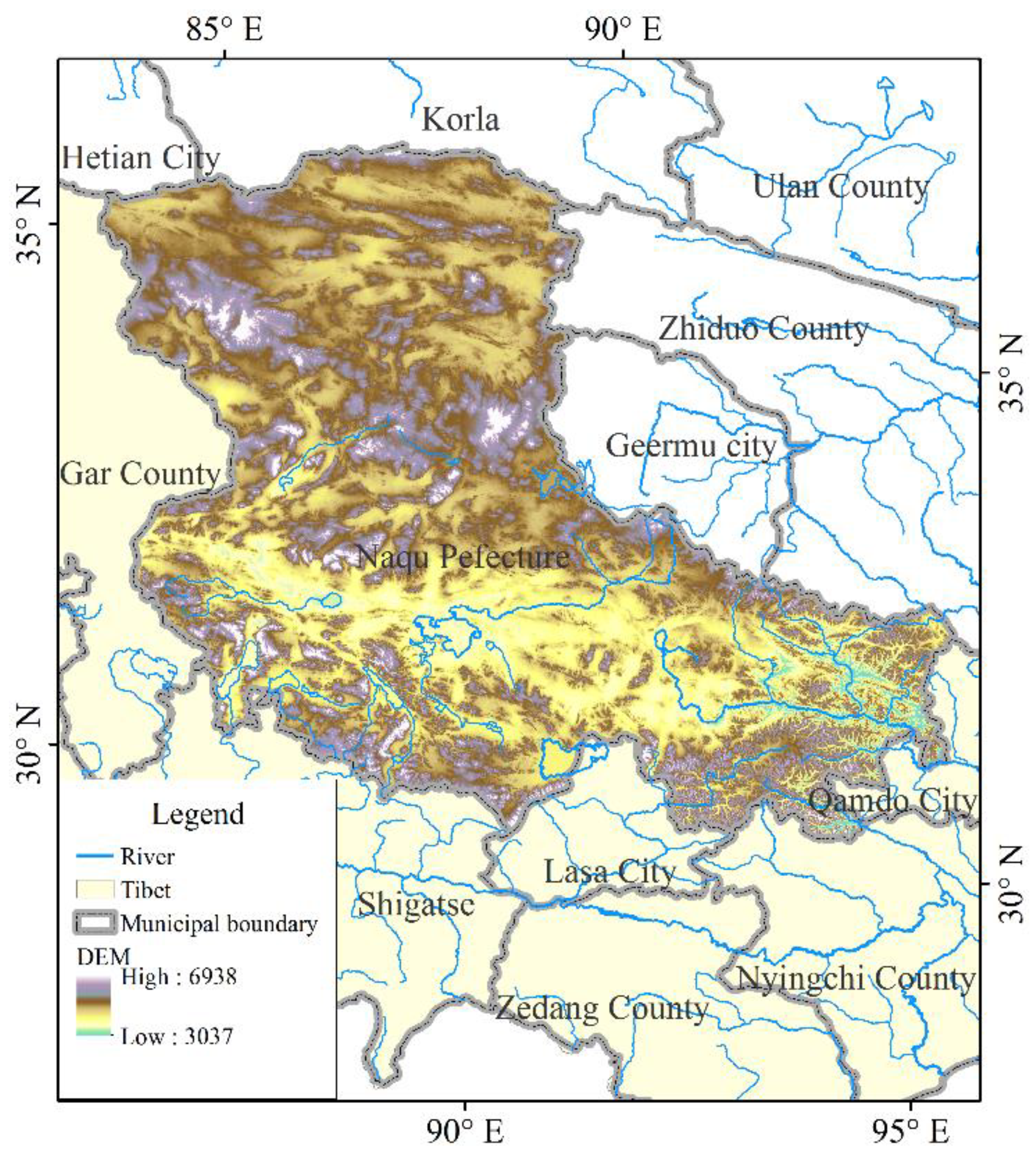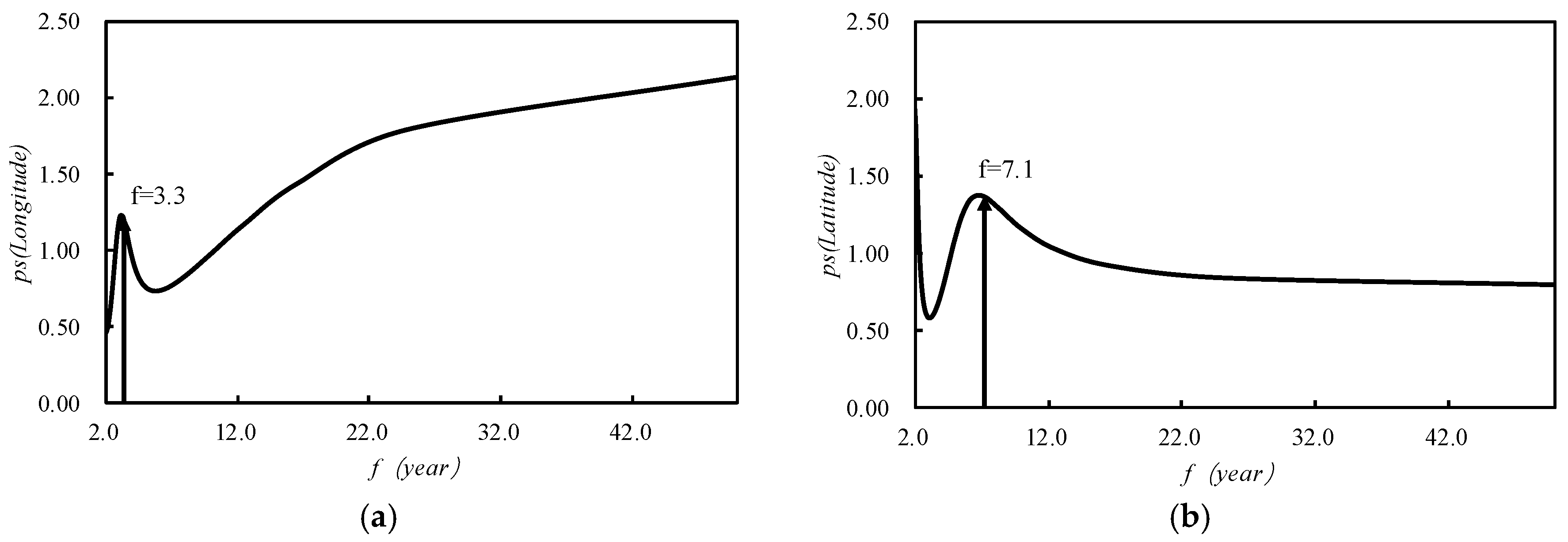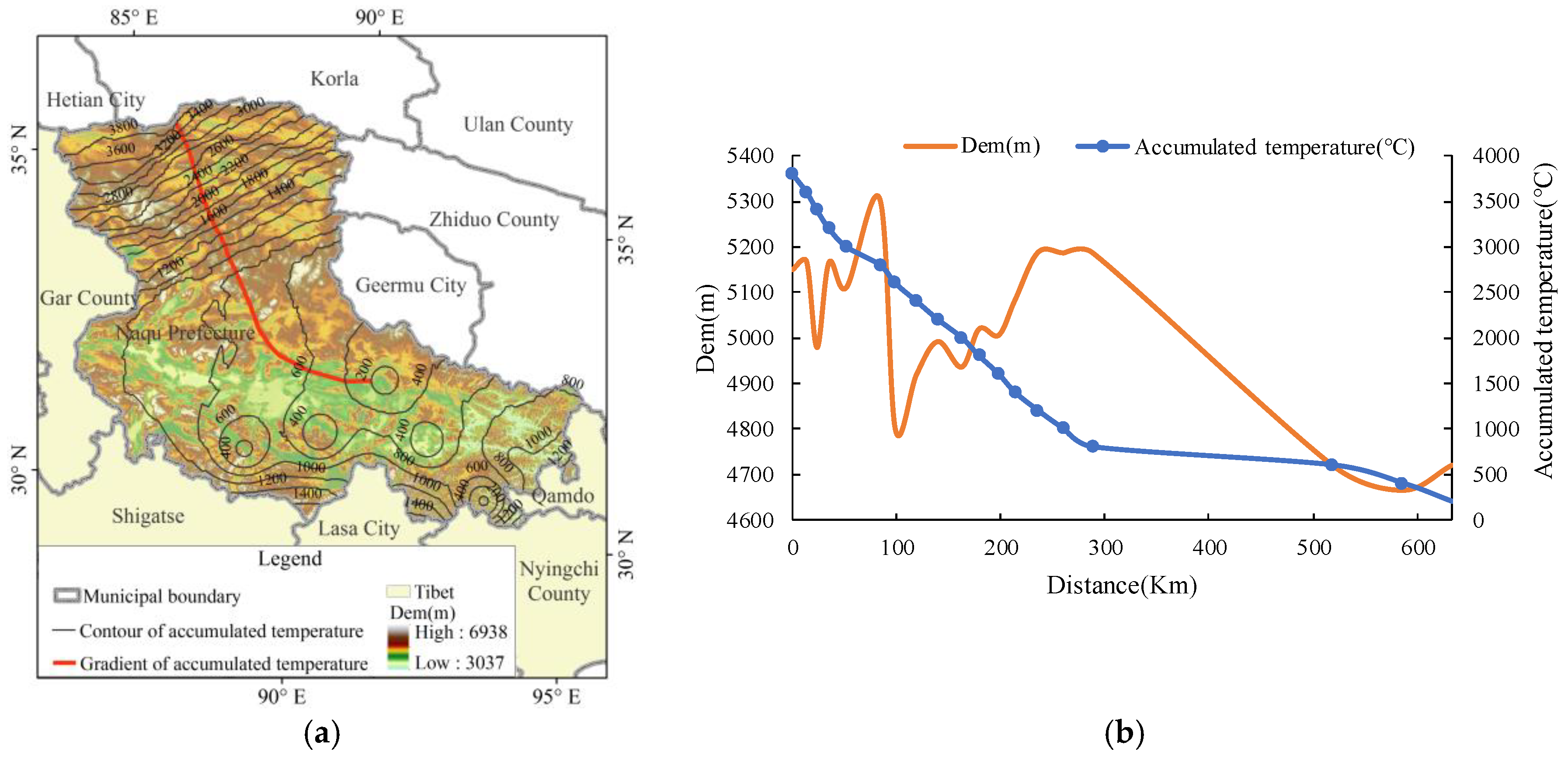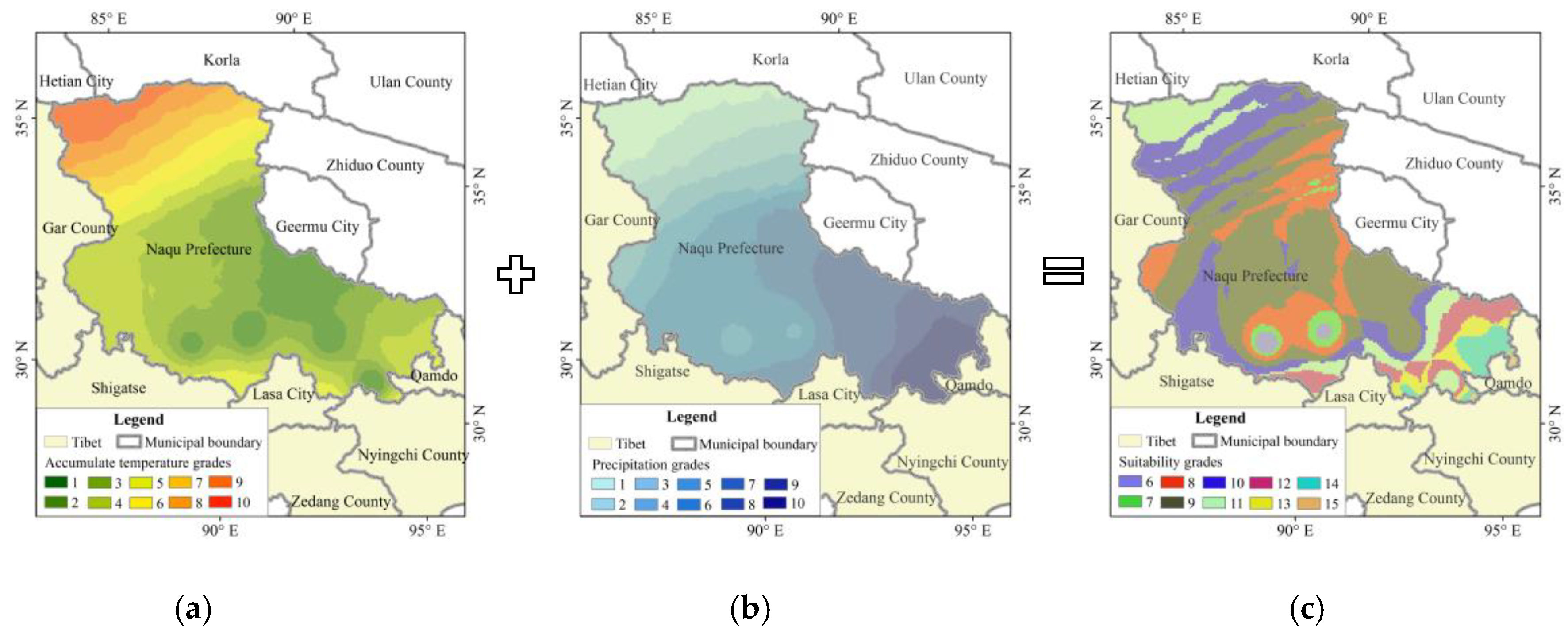Variation of Hydrothermal Conditions under Climate Change in Naqu Prefecture, Tibet Plateau, China
Abstract
1. Introduction
2. Materials and Methods
2.1. Study Site
2.2. Meteorological Data
2.3. Contour Generation and Quantification of Spatial Position
2.4. Time Series Analysis of Spatial Position of Contour Lines
2.5. Division of Hydrothermal Conditions Suitability for Vegetations
3. Results
3.1. Characteristics of Annual Precipitation and the 500 mm Precipitation
3.1.1. Spatial Characteristics of Annual Precipitation
3.1.2. Trend Analysis of the 500 mm Precipitation
3.1.3. Periodicity Analysis of the 500 mm Precipitation
3.1.4. Catastrophe Analysis of the 500 mm Precipitation
3.2. Characteristics of Annual Accumulated Temperature and the 2000 °C Accumulated Temperature
3.2.1. Spatial Characteristics of Annual Accumulated Temperature
3.2.2. Trend Analysis of the 2000 °C Accumulated Temperature
3.2.3. Periodicity Analysis of the 2000 °C Accumulated Temperature
3.2.4. Catastrophe Analysis of the 2000 °C Accumulated Temperature
3.3. Analysis of Growth Conditions of Vegetations in Naqu Prefecture
3.4. Response Analysis of Ecosystem in Naqu Prefecture
4. Discussion
4.1. Can Trees Be Planted in Alpine Areas Like Naqu Prefecture?
4.2. Methods and Thresholds Aiming at Specific Areas Are Needed
4.3. Climate Change Adaptation of Ecosystem
5. Conclusions
- On the interdecadal scale, the 500 mm annual precipitation contour in Naqu Prefecture showed a slight shift to the southeast in the 1970s, then shifted to the northwest in the 1980s. The 2000 °C accumulated temperature contour showed an offset to the northwest in the 1970s and 1980s, and moved back to the southeast in the 1990s, then continued to move southward after the 2000s.
- The 500 mm annual precipitation contour presented a westward shifting trend and a southward shifting trend in longitude and latitude, respectively. The coordinate of the center point of the contour had a 3.3-year period and a 7.1-year period in longitude and latitude, respectively. The longitude of the center point had a catastrophe point around 1996, while there was no catastrophe point in the zonal direction.
- The 2000 °C accumulated temperature contour showed no significant westward and northward shifting trend in the meridional and zonal directions. The center point of the contour had a 2.8-year period and a 7-year sub-period in the meridional direction, while there was no significant period in the zonal direction. The longitude of the center point had a mutation point between 1966 and 1967, and the latitude had a catastrophe point between 2005 and 2006.
- When in the same vegetation zone, the annual precipitation in Naqu Prefecture was generally 17 mm to 129 mm higher than the national average, while the accumulated temperature level is generally 35 °C to 1338 °C lower than the national average. It was speculated that the same vegetation may require more precipitation and less accumulated temperature when grown in alpine regions. When the accumulated temperature and precipitation are spatially displaced, there may be a spatial redistribution of vegetation zones in Naqu Prefecture.
- At present, the hydrothermal conditions suitability of vegetation growth in Naqu Prefecture gradually got worse from southeast to northwest. In the future, affected by the spatial displacement of precipitation and accumulated temperature, the areas with suitable hydrothermal conditions suitable for vegetation growth show a northwestward shifting tendency.
Author Contributions
Funding
Conflicts of Interest
References
- Xue, Z.; Gebremichael, M.; Ahmad, R.; Weldu, M.L.; Bagtzoglou, A.C. Impact of temperature and precipitation on propagation of intestinal schistosomiasis in an irrigated region in Ethiopia: Suitability of satellite datasets. Trop. Med. Int. Health 2011, 16, 1104–1111. [Google Scholar] [CrossRef] [PubMed]
- Gurdak, D.; Aragão, L.E.O.C.; Rozas-Dávila, A.; Huasco, W.; Cabrera, K.; Doughty, C. Assessing above-ground woody debris dynamics along a gradient of elevation in Amazonian cloud forests in Peru: Balancing above-ground inputs and respiration outputs. Trans. Proc. Bot. Soc. Edinb. 2014, 7, 143–160. [Google Scholar] [CrossRef]
- Chang, C.T.; Wang, S.F.; Vadeboncoeur, M.A. Relating vegetation dynamics to temperature and precipitation at monthly and annual timescales in Taiwan using MODIS vegetation indices. Int. J. Remote Sens. 2014, 35, 598–620. [Google Scholar] [CrossRef]
- Beharry, S.L.; Clarke, R.M.; Kumarsingh, K. Variations in extreme temperature and precipitation for a caribbean island: Trinidad. Theor. Appl. Climatol. 2015, 122, 783–797. [Google Scholar] [CrossRef]
- Dash, S.K.; Mamgain, A.; Pattnayak, K.C.; Giorgi, F. Spatial and Temporal Variations in Indian Summer Monsoon Rainfall and Temperature: An Analysis Based on RegCM3 Simulations. Pure Appl. Geophys. 2013, 170, 655–674. [Google Scholar] [CrossRef]
- Jiantao, F.U.; Sun, D.; Chen, L.; Yinglin, L.U.; Zhao, H.H.; Dai, S.X.; Gong, H.L.; An, Y.X. Relationship analysis of the temperature and precipitation with the yield of sugarcane. Chin. J. Trop. Agric. 2018, 6, 16–20. [Google Scholar]
- Waha, K.; Müller, C.; Rolinski, S. Separate and combined effects of temperature and precipitation change on maize yields in sub-saharan africa for mid- to late-21st century. Glob. Planet. Chang. 2013, 106, 1–12. [Google Scholar] [CrossRef]
- Woznicki, T.L.; Heide, O.M.; Sønsteby, A.; Wold, A.B.; Remberg, S.F. Effects of temperature and precipitation on yield and chemical composition of black currant fruits (Ribes nigrum L.). Acta Hortic. 2016, 1133, 183–188. [Google Scholar] [CrossRef]
- Pei, Q.; Zhang, D.D.; Li, G.; Forêt, P.; Lee, H.F. Temperature and precipitation effects on agrarian economy in late imperial china. Environ. Res. Lett. 2016, 11, 064008. [Google Scholar] [CrossRef]
- Dong, J.W.; Liu, J.Y.; Tao, F.; Xu, X.L.; Wang, J.B. Spatio-temporal ch-anges in annual accumulated temperature in China and the effectson cropping systems 1980s to 2000. Clim. Res. 2009, 40, 37–38. (In Chinese) [Google Scholar] [CrossRef]
- Bai, Q.F.; Huo, Z.G.; Shi-Kui, L.I.; Hai-Jiang, D.U.; Nan, H.E.; Jiang, Y. Comparison of accumulated temperature above 10 °C before and after the year 1978 in china. Chin. J. Appl. Ecol. 2008, 19, 1810–1816. (In Chinese) [Google Scholar]
- Wang, H.; Yan, D.H.; Qin, D.Y.; Wang, J.H. A study of the spatial shift of 400 mm -rainfall contours in the yellow river basin during recent 50 years. Adv. Earth Sci. 2005, 20, 649–655. (In Chinese) [Google Scholar]
- Compiler Group of Physical Geography of China. Physical Geography of China, 3rd ed.; Hingher Education Press: Beijing, China, 1993. (In Chinese) [Google Scholar]
- Yu, W.H.; Nan, W.H. Isohyet 400 mm, the Great Wall and the Dividing Line Between Farming Tribes and Nomadic Peoples. J. Shanghai Jiaotong Univ. (Philos. Soc. Sci.) 2009, 17, 48–54. [Google Scholar]
- Chen, M.; Yang, L.I.; Gong, Y.; Dadao, L.U.; Hua, Z. The population distribution and trend of urbanization pattern on two sides of hu huanyong population line: A tentative response to premier li keqiang. Acta Geogr. Sin. 2016, 71, 179–193. [Google Scholar]
- Wang, J.S.; Jin, X.B.; Cao, X.; Zhou, Y.K. Changes of the northern limit of cultivation in northern agro-pastoral ecotone in Qing Dynasty. J. Arid Land Resour. Environ. 2015, 29, 20–25. [Google Scholar] [CrossRef]
- Guo, B.D. Differences in Response to Climate Change of Picea purpurea and Abies faxoniana at Different Elevations and Slopes in Western Sichuan Plateau, China. Master’s Thesis, Northeast Forest University, Harbin, China, June 2016. [Google Scholar]
- Sun, H.L.; Zheng, D.; Xia, J.; Chen, F.H.; Cheng, S.K.; Shen, L.; Wang, Y.F.; Lin, J.B.; Jiang, Y.; Dong, S.C.; et al. Experts Interviews: Disputes on Current Hotspot Issues in Resources and Environment. J. Nat. Resour. 2018, 33, 1092–1102. [Google Scholar]
- Cheng, Y.J.; Tang, Z.M. On the roof the world, taking planting trees as a kind of “practice”. China’s Tibet. 2018, 1, 36–37. (In Chinese) [Google Scholar]
- Shi, Y.L.; Song, L. Calibration of TRMM 3B43 over Tibetan Plateau during 1998–2012. Arid Land Geogr. 2015, 38, 900–911. [Google Scholar]
- Wen, W.Q.; Zhang, B.P.; Yu, P.; Zhao, F.; Zhang, S. TRMM-Data-Based Spatial and Seasonal Patterns of Precipitation in the Qinghai-Tibet Plateau. Sci. Geogr. Sin. 2013, 33, 999–1005. [Google Scholar]
- Shi, X. Study on Distributed Hydrological Simulation and Drought Evaluation Method in Luanhe River Basin Based on SWAT Model. Ph.D. Thesis, University of Chinese Academy of Sciences, Beijing, China, 2013. [Google Scholar]
- Li, W.; Liu, Y.; Tian, C.T. Case study of Interpolation and Prolongation of Hydrologic Series. Technol. Innov. Appl. 2017, 35, 84–85. [Google Scholar]
- Hevesi, J.; Flint, A.; Istok, J. Precipitation Estimation in Mountainous Terrain Using Multivariate Geostatistics. Part II: Isohyetal Maps. J. Appl. Meteorol. 1992, 31, 677–688. [Google Scholar] [CrossRef]
- Hevesi, J.; Istok, J.; Flint, A. Precipitation Estimation in Mountainous Terrain Using Multivariate Geostatistics. Part I: Structural Analysis. J. Appl. Meteorol. 1992, 31, 661–676. [Google Scholar] [CrossRef]
- Resource and Environment Data Cloud platform of Chinese Academy of Sciences. Available online: http://www.resdc.cn (accessed on 25 August 2018).
- Ding, J.; Deng, Y.R. Stochastic Hydrology, 3rd ed.; Chengdu University of Science and Technology Press: Chengdu, China, 1981. [Google Scholar]
- Cao, H. The Maximum Entropy Spectrum Analysis of Meteorological Historical Series. Chin. Sci. Bull. 1979, 24, 351–355. [Google Scholar]
- Berger, W.H.; Labeyrie, L.D. Abrupt Climatic Change—An Introduction; Springer: Dordrecht, The Netherlands, 1987; Volume 216, pp. 3–22. [Google Scholar]
- Weber, E.; Kendall, M. Multivariate Analysis. Charles Griffin b Co. LTD. London, High Wycombe 1975. 210 s., 9 Abb., 27 Tab., 1 Anhang, £ 6,80. Biom. J. 1977, 19, 309. [Google Scholar] [CrossRef]
- Yamamoto, R.; Iwashima, T.; Kazadi, S.-N. Climatic jump: A hypothesis in climate diagnostic. J. Meteorol. Soc. Jpn. 1985, 63, 1157–1160. [Google Scholar] [CrossRef]
- Ke, L.; Ding, X.; Li, W.; Qiu, B. Remote Sensing of Glacier Change in the Central Qinghai-Tibet Plateau and the Relationship with Changing Climate. Remote Sens. 2017, 9, 114. [Google Scholar] [CrossRef]
- Wang, C.; Ma, Z. Quasi-3-yr Cycle of Rainy Season Precipitation in Tibet Related to Different Types of ENSO during 1981–2015. J. Meteorol. Res. 2018, 32, 181–190. [Google Scholar] [CrossRef]
- Yang, C.; Shen, W.; Lin, N. Temp-spatial changes of temperature and precipitation over the Tibet Plateau during the last 50 years. J. Arid Land Res. Environ. 2013, 27, 167–172. [Google Scholar]
- Cheung, M.C.; Zong, Y.; Zheng, Z. Holocene temperature and precipitation variability on the central Tibetan Plateau revealed by multiple palaeo-climatic proxy records from an alpine wetland sequence. Holocene 2017, 27, 095968361770222. [Google Scholar] [CrossRef]
- Kong, D.D.; Zhang, Q.; Huang, W.L.; Gu, X.H. Vegetation phenology change in Tibetan Plateau from 1982 to2013 and its related meteorological factors. Acta Geogr. Sin. 2017, 72, 39–52. [Google Scholar]
- He, Q.J.; Zhou, G.S. The climatic suitability for maize cultivation in China. Chin. Sci. Bull. 2012, 57, 395–403. [Google Scholar] [CrossRef]
- Giovanelli, J.G.R.; Haddad, C.F.B.; Alexandrino, J. Predicting the potential distribution of the alien invasive American bullfrog (Lithobates atesbeianus) in Brazil. Biol. Invas. 2008, 10, 585–590. [Google Scholar] [CrossRef]
- Cheng, J.; Cheng, J.M.; Hu, T.M. Distribution responses of Lespedeza davurica community on Loess Plateau to climate change. Chin. J. Appl. Ecol. 2011, 22, 35–40. [Google Scholar]
- Hou, P.; Liu, Y.; Xie, R.; Ming, B.; Ma, D.; Li, S. Temporal and spatial variation in accumulated temperature requirements of maize. Field Crops Res. 2014, 158, 55–64. [Google Scholar] [CrossRef]
- Cheng, G.; Wu, T. Responses of permafrost to climate change and their environmental significance, Qinghai-Tibet Plateau. J. Geophys. Res. Earth Surf. 2007, 112, 1–10. [Google Scholar] [CrossRef]
- Zhu, X.; Wu, T.; Li, R.; Wang, S.; Hu, G.; Wang, W. Characteristics of the ratios of snow, rain and sleet to precipitation on the qinghai-tibet plateau during 1961–2014. Quant. Int. 2016, 444, 137–150. [Google Scholar] [CrossRef]
- Zhao, J.; Luo, T.; Li, R.; Wei, H.; Li, X.; Du, M. Precipitation alters temperature effects on ecosystem respiration in Tibetan alpine meadows. Agric. For. Meteorol. 2018, 252, 121–129. [Google Scholar] [CrossRef]
- Sun, J.; Qin, X. Precipitation and temperature regulate the seasonal changes of NDVI across the Tibetan Plateau. Environ. Earth Sci. 2016, 75, 1–9. [Google Scholar] [CrossRef]
- Liu, W.; Liu, K.; Zhang, C.H. Effect of accumulated temperature on seed germination-a case study of 12 Compositae species on the eastern Qinghai-Tibet Plateau of China. Chin. J. Plant Ecol. 2011, 35, 751–758. [Google Scholar] [CrossRef]
- Zhang, J.; Shen, X.; Wang, B. Changes in precipitation extremes in Southeastern Tibet, China. Quant. Int. 2015, 380–381, 49–59. [Google Scholar] [CrossRef]
- Wu, L.Y.; Zhang, J.Y.; Dong, W.J. Vegetation effects on mean daily maximum and minimum surface air temperatures over China. Chin. Sci. Bull. 2011, 56, 900–905. [Google Scholar]
- Galvão, L.S.; Breunig, F.M.; Teles, T.S. Investigation of terrain illumination effects on vegetation indices and VI-derived phenological metrics in subtropical deciduous forests. Geod. Mapp. Photogramm. 2016, 53, 360–381. [Google Scholar] [CrossRef]
- Chasmer, L.; Hopkinson, C.; Montgomery, J.; Petrone, R. A Physically Based Terrain Morphology and Vegetation Structural Classification for Wetlands of the Boreal Plains, Alberta, Canada. Can. J. Remote Sens. 2016, 42, 521–540. [Google Scholar] [CrossRef]
- Otkin, J.A.; Anderson, M.C.; Hain, C.; Svoboda, M.; Johnson, D.; Mueller, R. Assessing the evolution of soil moisture and vegetation conditions during the 2012 united states flash drought. Agric. For. Meteorol. 2016, 218–219, 230–242. [Google Scholar] [CrossRef]
- Gevaert, A.I.; Parinussa, R.M.; Renzullo, L.J.; van Dijk, A.I.J.M.; de Jeu, R.A.M. Spatio-temporal evaluation of resolution enhancement for passive microwave soil moisture and vegetation optical depth. Int. J. Appl. Earth Obs. Geoinf. 2016, 45, 235–244. [Google Scholar] [CrossRef]
- Wang, H.; Liu, D.; Lin, H. NDVI and vegetation phenology dynamics under the influence of sunshine duration on the Tibetan plateau. Int. J. Climatol. 2015, 35, 687–698. [Google Scholar] [CrossRef]
- Okin, G.S.; Gillette, D.A. Distribution of vegetation in wind-dominated landscapes: Implications for wind erosion modeling and landscape processes. J. Geophys. Res. Atmos. 2001, 106, 9673–9683. [Google Scholar] [CrossRef]
- Munson, S.M.; Belnap, J.; Okin, G.S. Responses of wind erosion to climate-induced vegetation changes on the Colorado Plateau. Proc. Natl. Acad. Sci. USA 2011, 108, 3854–3859. [Google Scholar] [CrossRef] [PubMed]
- Álvarez, J. Changes in soils and vegetation in a Mediterranean coastal salt marsh impacted by human activities. Estuar. Coast. Shelf Sci. 2007, 73, 510–526. [Google Scholar] [CrossRef]
- Ma, W.; Wang, X.; Zhou, N.; Jiao, L. Relative importance of climate factors and human activities in impacting vegetation dynamics during 2000–2015 in the Otindag Sandy Land, northern China. J. Arid Land 2017, 9, 558–567. [Google Scholar] [CrossRef]
- Cortizas, A.M.; Mighall, T.; Pontevedra-Pombal, X.; Muñoz, J.C.N.; Varela, E.P.; Rebolo, R.P. Linking changes in atmospheric dust deposition, vegetation change and human activities in northwest Spain during the last 5300 years. Holocene 2005, 15, 698–706. [Google Scholar] [CrossRef]















| Vegetation Zones | Annual pre. (mm) | Annual Accumulated Temp. (°C) | ||||
|---|---|---|---|---|---|---|
| Naqu | National | Diff. | Naqu | National | Diff. | |
| Alpine grassland zone | 304 | 266 | 39 | 1126 | 1218 | −91 |
| Alpine shrub meadow zone | 585 | 566 | 19 | 849 | 804 | 45 |
| Alpine meadow zone | 478 | 420 | 57 | 505 | 541 | −35 |
| Cold-temperate coniferous forest zone | 651 | 616 | 35 | 767 | 2105 | −1338 |
| Alpine desert zone | 76 | 60 | 17 | 3389 | 3635 | −246 |
| Warm grassland zone | 515 | 386 | 129 | 1034 | 1437 | −403 |
© 2018 by the authors. Licensee MDPI, Basel, Switzerland. This article is an open access article distributed under the terms and conditions of the Creative Commons Attribution (CC BY) license (http://creativecommons.org/licenses/by/4.0/).
Share and Cite
Gong, B.; Weng, B.; Yan, D.; Qin, T.; Wang, H.; Bi, W. Variation of Hydrothermal Conditions under Climate Change in Naqu Prefecture, Tibet Plateau, China. Int. J. Environ. Res. Public Health 2018, 15, 2271. https://doi.org/10.3390/ijerph15102271
Gong B, Weng B, Yan D, Qin T, Wang H, Bi W. Variation of Hydrothermal Conditions under Climate Change in Naqu Prefecture, Tibet Plateau, China. International Journal of Environmental Research and Public Health. 2018; 15(10):2271. https://doi.org/10.3390/ijerph15102271
Chicago/Turabian StyleGong, Boya, Baisha Weng, Denghua Yan, Tianling Qin, Hao Wang, and Wuxia Bi. 2018. "Variation of Hydrothermal Conditions under Climate Change in Naqu Prefecture, Tibet Plateau, China" International Journal of Environmental Research and Public Health 15, no. 10: 2271. https://doi.org/10.3390/ijerph15102271
APA StyleGong, B., Weng, B., Yan, D., Qin, T., Wang, H., & Bi, W. (2018). Variation of Hydrothermal Conditions under Climate Change in Naqu Prefecture, Tibet Plateau, China. International Journal of Environmental Research and Public Health, 15(10), 2271. https://doi.org/10.3390/ijerph15102271






